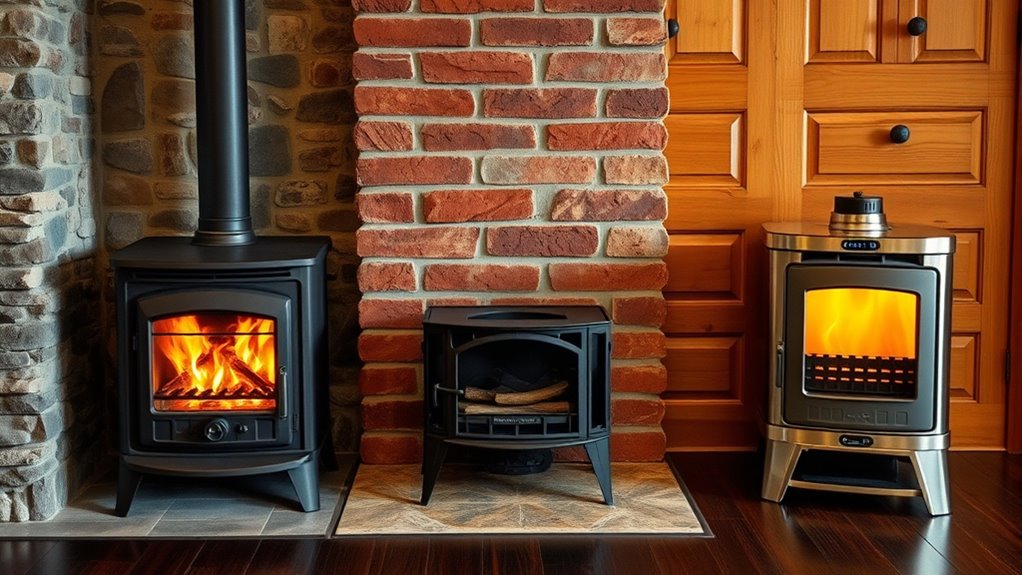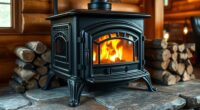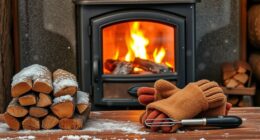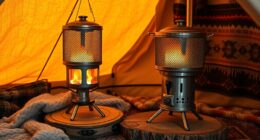Understanding wood stoves involves knowing their types, such as catalytic and non-catalytic models, each offering different efficiencies and features. You’ll find materials like cast iron, steel, and soapstone, which impact durability and heat retention. Proper sizing, firebox design, and door options also matter for performance and convenience. Choosing the right stove depends on your needs and budget, and exploring more will help you make an informed decision based on these key features.
Key Takeaways
- Wood stoves are designed to burn firewood efficiently, providing radiant heat for warming indoor spaces.
- Main types include catalytic stoves, which use honeycomb burn systems, and non-catalytic stoves, which rely on baffles.
- Material options like cast iron, steel, and soapstone affect heat retention, durability, and weight.
- Proper sizing and airflow controls ensure optimal combustion, efficiency, and safe operation.
- Features such as door designs, maintenance requirements, and warranty support influence long-term performance.
How Wood Stoves Operate and Their Efficiency
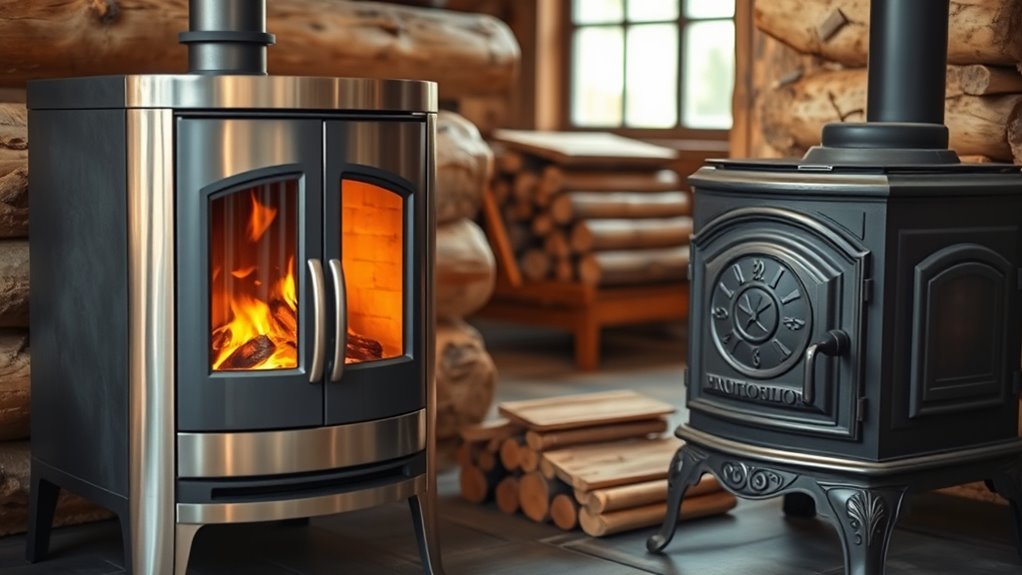
Wood stoves work by burning firewood in a designated firebox, producing radiant heat that effectively warms your space. The process relies on combustion, where airflow controls how well the fire burns, directly impacting heat output and efficiency. Modern stoves are designed with features like dampers and baffles to optimize airflow, ensuring complete burning of the wood. EPA-certified stoves meet strict standards for cleaner burning, often using catalytic converters to burn gases more completely, reducing emissions. These stoves typically achieve efficiency ratings of 70% to 80%, meaning more of the firewood’s energy converts into usable heat. To maximize performance, use seasoned, dry firewood and maintain proper airflow, which enhances combustion efficiency, minimizes smoke, and prevents creosote buildup inside your stove.
Exploring Different Types of Wood Stoves

Have you ever wondered what sets different wood stoves apart? The main types of wood stoves are catalytic and non-catalytic models. Catalytic stoves use a honeycomb burn system that burns gases more efficiently, offering higher efficiency and cleaner emissions. Non-catalytic stoves rely on a baffle system, are simpler to maintain, and tend to be more affordable, though they may produce more smoke. Both types can feature various stove materials like cast iron, steel, or soapstone, affecting heating performance. When choosing, consider EPA certification for efficiency and emissions standards. Your decision depends on your budget, maintenance preferences, and heating needs. Here’s a quick comparison:
| Type | Burn System | Maintenance | Efficiency | Cost |
|---|---|---|---|---|
| Catalytic Wood Stove | Honeycomb catalyst | Regular catalyst replacement | Higher, cleaner | Higher |
| Non-Catalytic Wood Stove | Baffle system | Easier, less costly | Slightly lower | Lower |
| Both Types | Varies | Varies | Varies | Varies |
Additionally, selecting the right stove materials can significantly impact the durability and heat retention of your stove over time. Incorporating advanced combustion techniques can also enhance overall performance and reduce emissions, making your stove more environmentally friendly. Understanding wood combustion efficiency is essential for optimizing heat output and minimizing fuel consumption. Furthermore, proper ventilation and air flow management are crucial for maintaining safe and efficient operation of your wood stove.
Materials Used in Manufacturing Wood Stoves
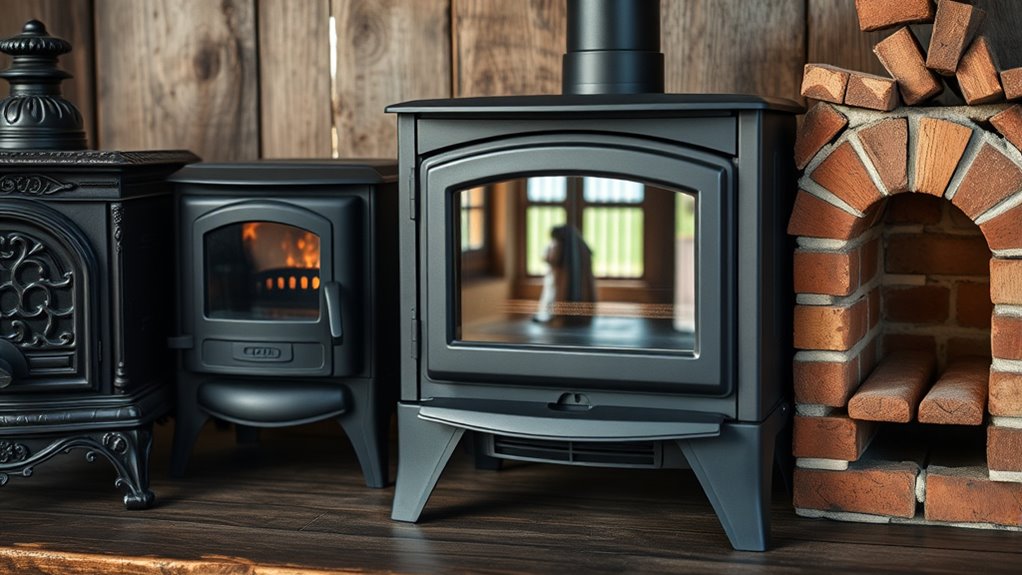
Different materials shape how your wood stove performs and looks. Cast iron, steel, and soapstone each have unique benefits and downsides that affect heat retention and durability. Understanding these options helps you choose the right material for your needs and style. For example, soapstone is known for its excellent heat retention properties, making it ideal for maintaining warmth over time. Additionally, choosing a material with efficient combustion capabilities can help reduce emissions and improve indoor air quality. Selecting materials with thermal mass can also influence how evenly heat is distributed throughout your space. Incorporating automation in heating systems can further optimize stove performance and energy efficiency. Utilizing materials with high thermal conductivity can enhance heat transfer and responsiveness in your stove.
Common Stove Materials
When choosing a wood stove, the materials used in manufacturing play a crucial role in its performance and appearance. Cast iron stoves are known for their durability, ornate designs, and excellent heat retention, making them ideal for traditional styles. Steel stoves heat up quickly, are budget-friendly, and feature simpler stove construction with lighter weight. Soapstone stoves stand out for their exceptional thermal mass, radiating warmth long after the fire dies out. The choice of materials impacts efficiency, maintenance, and longevity. Cast iron offers a classic look and durability, while steel provides affordability and quick heating. Soapstone’s heat retention makes it perfect for consistent warmth. Understanding these common stove materials helps you select a stove that aligns with your heating needs and aesthetic preferences. Additionally, material choices also influence the stove’s ability to withstand prolonged use and resist corrosion over time. The thermal properties of each material determine how effectively the stove distributes heat throughout your space. Furthermore, selecting the right materials can also affect the stove’s overall weight and ease of installation. Incorporating advanced manufacturing techniques can improve durability and performance of modern wood stoves. Recognizing the thermal mass of different materials can help optimize heat distribution and energy efficiency in your living space.
Material Benefits & Drawbacks
Choosing the right material for your wood stove involves weighing its benefits and drawbacks. Cast-iron offers durability and excellent heat retention, lasting for years and often featuring traditional, ornate designs. Steel stoves heat quickly and are budget-friendly but tend to cool down fast and may warp over time. Soapstone provides superior heat retention, radiating warmth for days after the fire’s out, though it tends to be more expensive and heavier. Heavier stove materials like cast-iron and soapstone offer stability, while steel models are lighter and easier to move. Each material has unique maintenance needs; cast-iron requires careful cleaning to prevent rust, soapstone resists scratches and stains, and steel needs regular checking for warping. Additionally, material durability plays a crucial role in the long-term performance of your stove. Considering the pollutant capture capabilities of different materials can help you select a stove that not only heats effectively but also maintains cleaner indoor air. The heat retention capacity of each material influences how long the warmth persists after the fire has died down, affecting your heating efficiency. Moreover, understanding technological advancements in stove designs can help improve efficiency and safety. Selecting materials with environmental impact in mind can contribute to more sustainable heating solutions. Your choice depends on balancing heat retention, durability, and maintenance.
Choosing the Right Size and Capacity
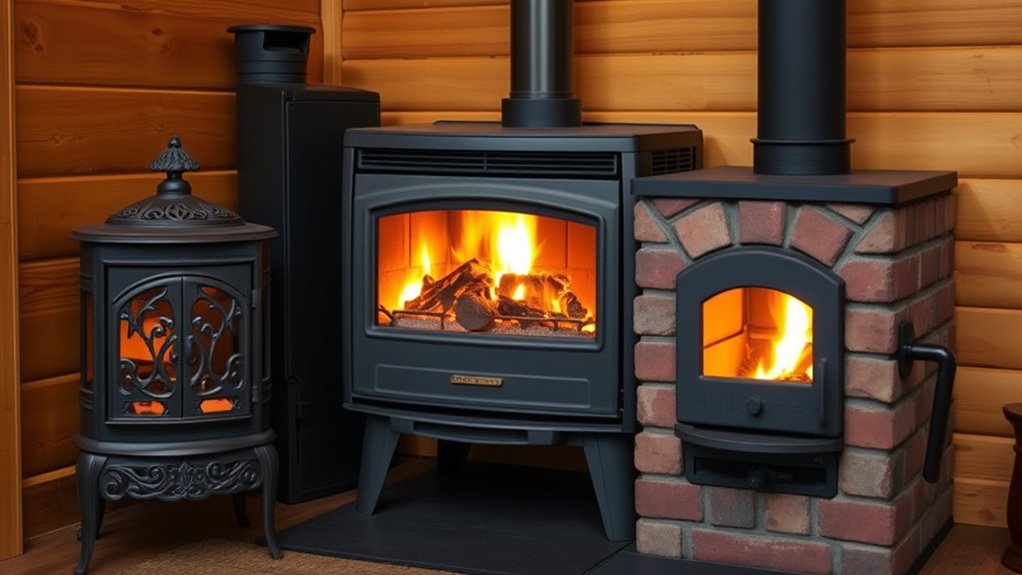
How do you select the right-sized wood stove for your home? Start by matching the stove size to your room square footage. Small models suit up to 1,000 sq. ft., medium for up to 2,000 sq. ft., and large for 3,000 sq. ft. spaces. Consider the BTU capacity; a stove with the right heat output guarantees efficient heating without overheating. Larger fireboxes provide longer burn times and consistent heat, which aligns with your heating needs. Use this guide to help with stove sizing:
| Room Square Footage | Recommended Stove Size |
|---|---|
| Up to 1,000 sq. ft. | Small |
| 1,001–2,000 sq. ft. | Medium |
| 2,001–3,000 sq. ft. | Large |
| BTU Range | 20,000–80,000 BTUs |
| Efficiency & Burn Time | Match to your insulation and climate |
Proper sizing maximizes stove efficiency and heat output.
Variations in Burn Technology: Catalytic vs. Non-Catalytic
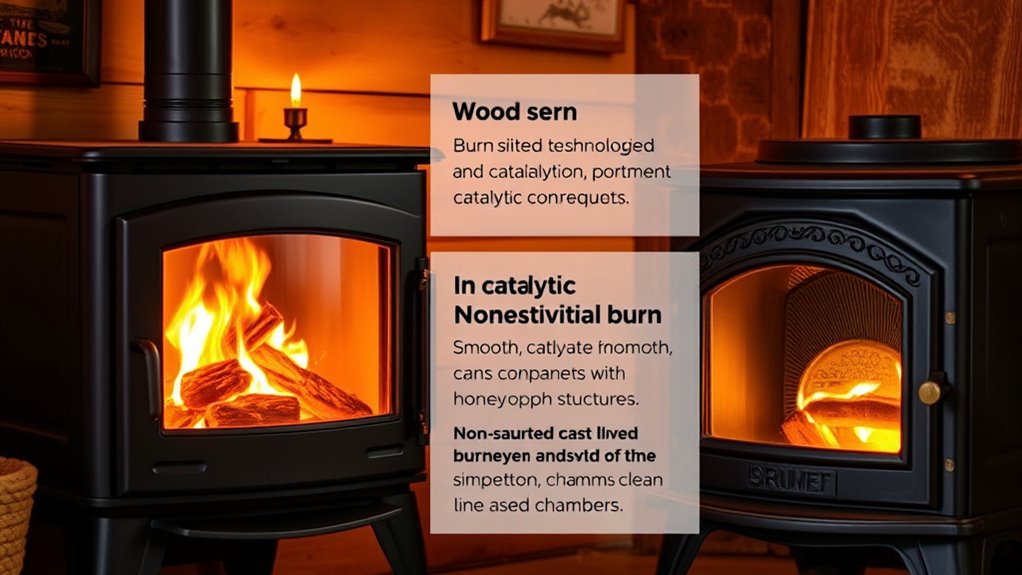
When choosing between catalytic and non-catalytic wood stoves, you’ll notice differences in emissions and efficiency. Catalytic models burn gases more completely, offering longer burn times but may require more maintenance, while non-catalytic stoves are simpler and often cheaper upfront. Understanding these variations helps you select a stove that balances cost, performance, and durability for your needs.
Emissions and Efficiency
Have you ever wondered why some wood stoves produce more smoke or burn more efficiently than others? The answer lies in their burn system and emissions control. Catalytic stoves use a ceramic honeycomb catalyst to enhance combustion, leading to lower emissions and higher efficiency. They operate at lower temperatures and often meet EPA standards for low emissions. They also require periodic maintenance to keep the catalyst functioning properly. Non-catalytic stoves rely on a baffle system and high-temperature combustion to achieve similar heat output, but usually emit more smoke and creosote. While non-catalytic models are simpler and more affordable, catalytic stoves tend to burn cleaner and more efficiently over time. Both technologies aim to meet EPA standards, but catalytic stoves generally provide a more environmentally friendly, high-efficiency burn. Understanding burn technology can be cultivated through understanding different burn technologies and experimenting with various stove types to optimize performance and emissions.
Maintenance and Durability
Maintenance and durability of wood stoves depend largely on their burn technology. Catalytic stoves use a ceramic honeycomb catalyst with precious metals like platinum or palladium, which wear out over time and require costly replacement every 3 to 5 years. Regular inspection of the catalytic combustor helps maintain efficiency and prolong its lifespan. Additionally, understanding the different design features of each stove can help optimize their longevity and efficiency. Being aware of the types of wood used can also impact the stove’s performance and maintenance needs. Proper cleaning and handling of the chimney and flue system are essential for both types to prevent creosote buildup and ensure safe operation. Non-catalytic stoves, relying on a baffle system and high-temperature combustion, generally need less maintenance and are easier and cheaper to repair. Both types can last around 10 to 20 years with proper care, but catalytic models may demand more attentive upkeep of the catalyst. Proper maintenance assures durability and peak performance, regardless of the burn technology you choose.
Cost and Performance
The choice between catalytic and non-catalytic wood stoves considerably impacts both your budget and heating performance. Catalytic stoves typically have a higher upfront cost due to the ceramic honeycomb catalyst, but they offer superior efficiency—around 70-80%—and cleaner emissions. They also maintain consistent heat output but require regular maintenance and catalyst replacement over time, which can increase repair costs. Non-catalytic stoves are more affordable initially and simpler to repair, making them a popular choice for budget-conscious users. While their efficiency is slightly lower—around 60-70%—they still deliver reliable performance with less maintenance. Both types meet EPA emission standards, but catalytic models often produce cleaner emissions and more efficient heating, making them a worthwhile investment for long-term performance.
Door Options and Design Features
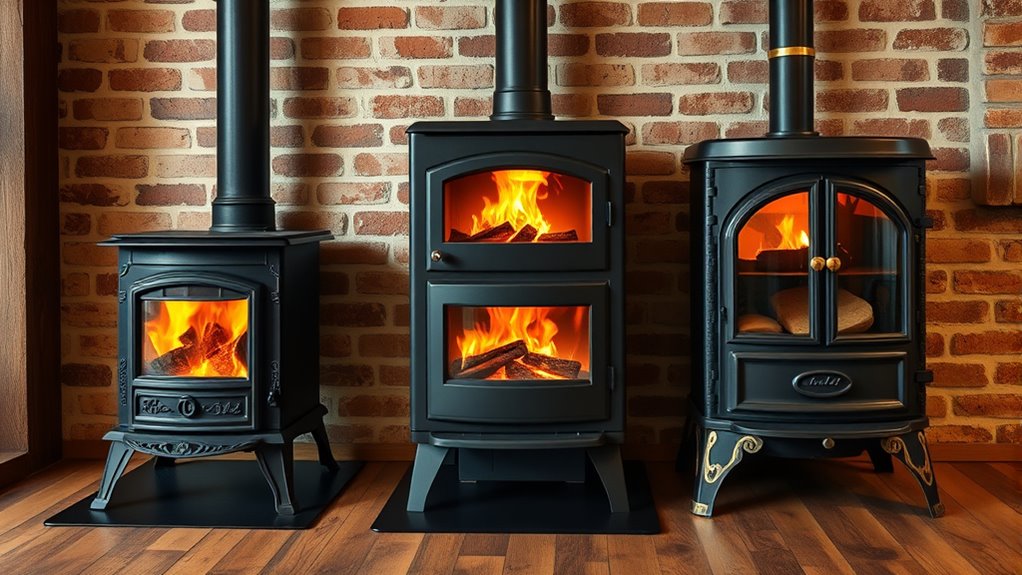
Choosing the right door option for your wood stove can considerably impact both its functionality and appearance. Your choice affects accessibility, maintenance, and visual appeal. Consider these options:
- Glass-door: Offers a beautiful view of the fire, enhancing aesthetic appeal, but requires more frequent cleaning and costs more.
- Side-door: Provides easier log placement and cleaning, making it practical for larger logs and frequent use.
- Single or double doors: Single-door stoves are simple and affordable, while double-door models improve access for loading and maintenance.
Door styles also influence stove design, whether you prefer the classic look of cast-iron stoves or sleek steel models. Your selection should balance ease of use with visual style to fit your space.
Log Capacity and Firebox Orientation
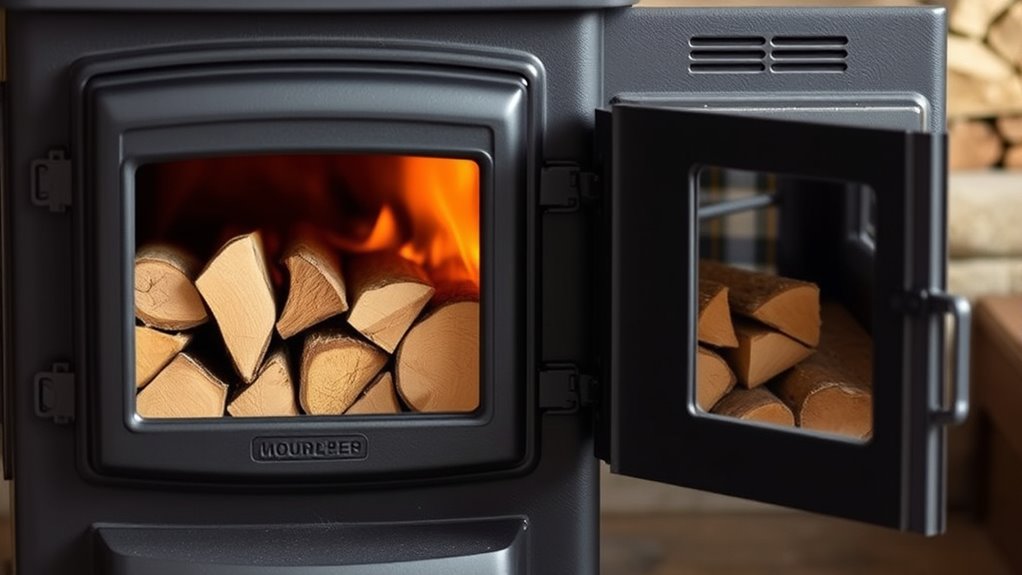
Selecting the right door style can influence how you load and manage logs, but understanding your stove’s firebox shape and orientation is key to maximizing efficiency. The firebox shape, often wider than long, affects log capacity and firebox design. Horizontal fireboxes accommodate longer logs, allowing for better log arrangement and sustained burns, while vertical fireboxes suit shorter logs, making loading easier and airflow more efficient. Firebox orientation determines the maximum log length and overall fire capacity, directly impacting combustion efficiency. A larger firebox size provides greater log capacity, but proper log placement—whether stacked or laid flat—optimizes heat output. By choosing a firebox shape and orientation suited to your needs, you enhance your stove’s performance and ensure longer, more efficient burns.
Essential Factors Before Selecting a Wood Stove
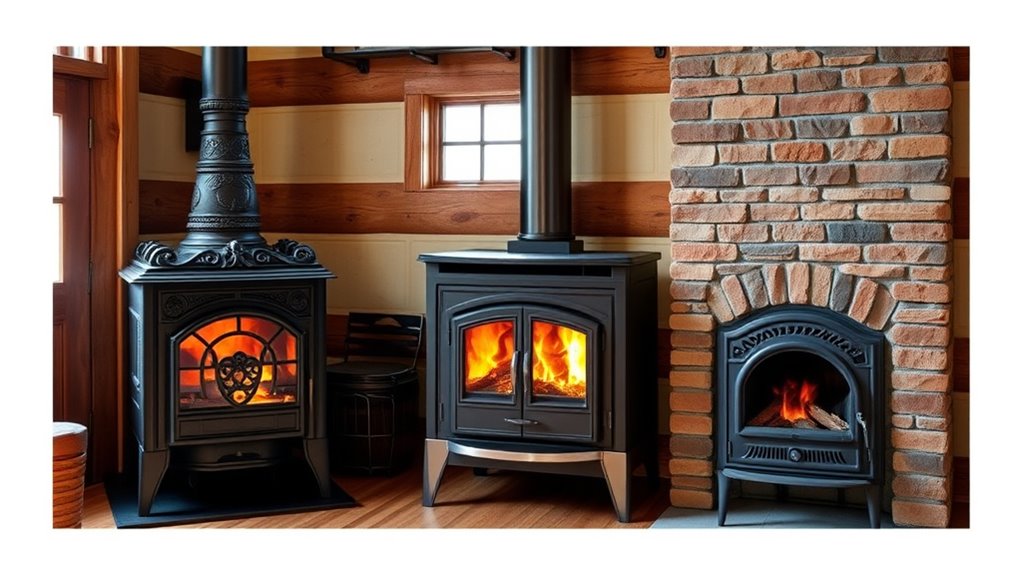
Before buying a wood stove, it’s essential to evaluate how well it matches your home’s size and heating needs. To do this effectively, consider these factors:
- BTU capacity: Match the stove’s BTU output to your square footage—around 20 BTUs per square foot—to ensure adequate heating.
- Fuel efficiency: Opt for EPA-certified models that maximize fuel efficiency, reduce emissions, and lower wood consumption.
- Type and material: Decide between catalytic or non-catalytic stoves, which influence maintenance and environmental impact, and choose materials like cast iron or soapstone for better heat retention and durability.
Proper installation and understanding of these factors help optimize performance, safety, and environmental friendliness of your wood stove.
Top Brands and Quality Considerations
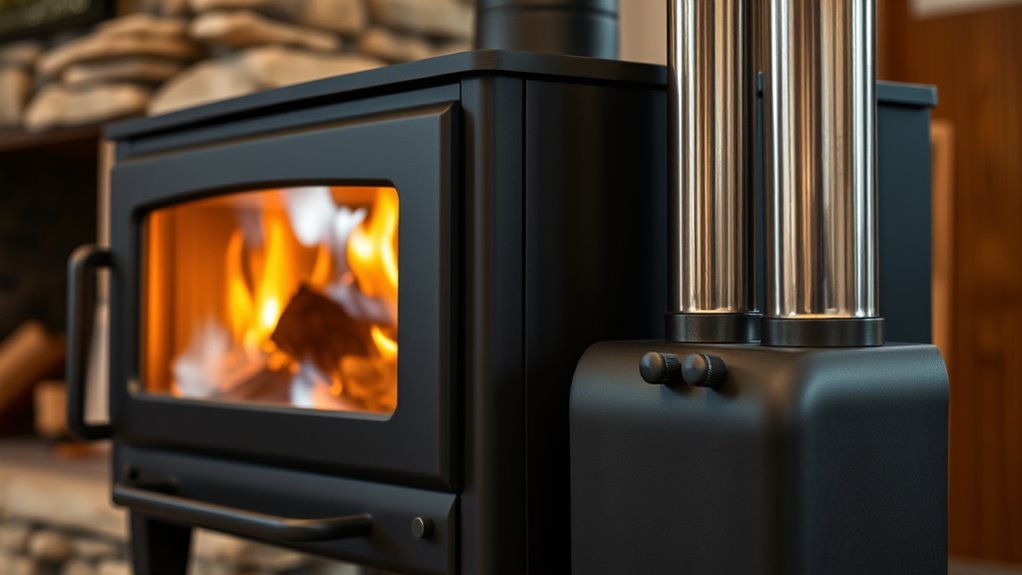
When considering the right wood stove for your home, the brands you trust play a significant role in ensuring durability, safety, and performance. Top brands like Jotul, Vermont Castings, and Pacific Energy are known for their high-quality wood stoves, with construction materials such as cast iron, soapstone, and high-grade steel that improve heat retention and reduce maintenance. Opting for certified EPA models ensures cleaner emissions, higher efficiency, and compliance with environmental standards. Quality considerations also include brand reputation, which reflects product reliability and customer satisfaction. Many premium brands incorporate advanced features like catalytic converters and smart technology, enhancing performance and aesthetics. Choosing a reputable brand with strong warranty support minimizes risks and guarantees your investment in a safe, reliable, high-performance stove.
Frequently Asked Questions
What Are the Different Types of Wood Stoves?
You’re asking about the different types of wood stoves. There are mainly catalytic and non-catalytic models, each with unique emission and efficiency features. You can choose from free-standing stoves, fireplace inserts, or built-in designs to suit your space. Materials like cast iron, steel, or soapstone influence heat retention and look. EPA-certified models guarantee cleaner burns, while styles range from simple doors to glass-paneled designs for convenience and aesthetics.
What Is the 3:2-10 Rule for Wood Stoves?
The 3:2-10 rule guides your wood stove installation for safety and efficiency. You should keep at least 3 inches of clearance from combustible materials, 2 inches around venting components, and make certain your chimney is at least 10 feet long. Following these guidelines helps prevent fires, promotes proper airflow, and guarantees your stove operates safely. Always check local codes and manufacturer instructions to stay compliant and keep your home secure.
What Is the Most Efficient Type of Wood Burning Stove?
You might think any wood stove does the job, but the most efficient one is a soapstone stove. Its dense material retains heat longer, radiating warmth for days after your fire dies. Unlike simple non-catalytic models, soapstone’s high heat retention means less firewood and more consistent warmth. If efficiency matters most, investing in a soapstone or catalytic stove could transform your heating experience, saving you money and energy.
What Is the Difference Between Type 1 and Type 2 Stove Board?
The difference between Type 1 and Type 2 stove boards lies in their fire resistance and installation flexibility. You’ll find that Type 1 boards are made of fire-resistant drywall or cement, providing basic protection with minimal clearance. Type 2 boards are thicker, more durable, and made from materials like ceramic tile or brick, allowing closer stove placement due to their superior heat shielding. Always follow building codes and manufacturer instructions for safety.
Conclusion
By understanding how wood stoves operate, exploring their types, and considering materials and features, you can make an informed choice. Assess the size and capacity, compare burn technologies, and evaluate door options and design features. Think about log capacity and firebox orientation, weigh essential factors, and consider top brands and quality. With this knowledge, you’re equipped to select a wood stove that offers efficiency, durability, and warmth for your home.

